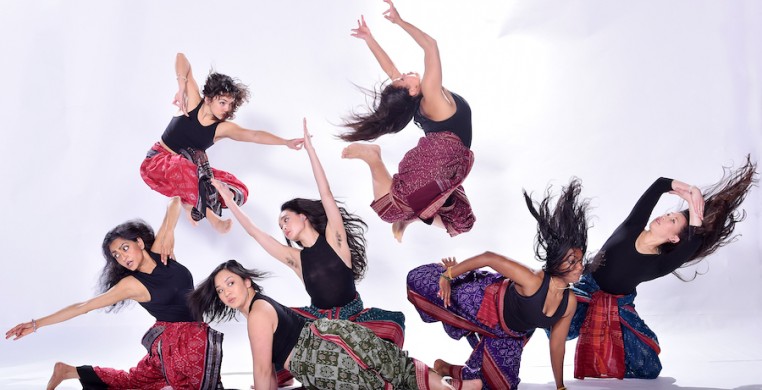The stage lights came up, illuminating the first dancers—and revealing myself and the other audience members who chose to sit on stage. In slow motion, the dancers moved through different series of short, strained phrases as the full cast entered. One dancer held her right wrist behind her back, struggling to free it from the grasp of the left hand. Another spiraled up and down from the floor, discomfort spreading through her face. Another traversed across the stage, two hands pressed in a “V” against her pelvis. With intense fog and dim lights streaking from above, the performers loomed over me as I sat so close I could have touched them. I felt their anguish and ferocity emanating from their strong, shaking hands and the vibrations their footwork sent through the floor. Their eyes searched through the space, meeting my own eyes with focused intensity, refusing to break contact. Immediately I was transfixed in the world the dancers built on stage, eager to understand their stories.
Running Feb 14-16 at The Dance Center at Columbia College Chicago, Ananya Dance Theatre’s “Shyamali: Sprouting Words” brought audiences up close and personal with women around the globe, particularly women of color, who stand against injustice. The unique dance style seen on stage—a contemporary blend of classical Indian movement forms—provided a voice for the performers to expose the many ways women resist oppression, showing strength and softness, communal connection and solo ferocity.
Ananya Chatterjea, choreographer and founder of Ananya Dance Theatre, creates work with her own contemporary Indian dance technique called Yorchha that she developed with her company. The technique dissects and intersects the classical Indian dance form Odissi, vinyasa yoga and the martial art form Chhau.
The resulting movement is clean and strong while also passionate and chaotic. These seemingly contradicting qualities work harmoniously in Yorchha, allowing the dancers to hold a powerful presence on stage. Seeing a cast of performers who are primarily women of color adds to the strength in the imagery presented.
The piece is structured as different sections that run together, marked by changes in music, lighting and props, which act as vignettes that highlight different women’s stories of struggle and the different ways they dissent.
A woman dressed in a white robe glides onto the stage at the end of the opening section, immediately taking charge of the space. The dancers, who by this point have established themselves as warrior women, soften at the presence of this god-like, matronly figure and quietly roll offstage. We audience members sitting onstage tune in to her presence, and by nothing other than strong and clear arm gestures, we are instructed to take our seats offstage.
The simple poetry that the woman in white proceeds to chant, and at times sing, leads into a section that feels almost like summer. With grass projected on the backdrop and soothing vocals, the dancers inch into the space with warm, subtle movements.
“Shyamali” continues like this, uncovering a range of emotions through variety in movement and scenic elements. The women on stage dance in unison and in trios and solos. They perform athletic sections where the ferocity of the footwork sends audible thumps throughout the space and the intensity of breath and jabbing arm movement creates loud “huh’s.” They dance tender sections where partners’ hands and arms smoothly intertwine, and they seamlessly and silently slide across the stage.
All the while, their eyes remain wide and focused, allowing me as an audience member to actively feel the emotions and stories they are portraying.
Through these vignettes, Ananya Dance Theatre exemplifies the complexity of womanhood, and the many ways in which a woman shows strength. The performance addresses multiple problems facing women around the world today, from physical abuse to environmental injustices. And as Chatterjea notes in the program, in addition to pain and trauma, “values of community, love, and solidarity” are at the heart of movements of resistance, and these values are also portrayed in the work.
Along with the visceral emotional performance by the dancers, the company’s unique dance technique is significant in communicating the variety of tones on stage. The mixture of three different movement traditions allows for vocabulary that is at once gestural and athletic. Dancers engage in intricate footwork while arms jab through large fighting motions. They pound across the stage while flicking through detailed mudras, or hand gestures.
The complexity of this movement allows for complexity in bodily expression. The movement and emotion of the performers is multidimensional, perfect for communicating the multidimensional stories of transnational women.
I did feel that the performance was a bit long, with some of the middle sections blurring together. I found the use of multiple costume changes and at least four different props to be distracting, or not fully realized as the props would disappear as suddenly as they were introduced.
But, I admire Chatterjea’s commitment to featuring a wide variety of perspectives in her work and using bold visuals to help build the setting for these perspectives. After learning that mirror shields used in the piece were inspired by similar shields created by an indigenous visual artist for Standing Rock protestors, I’m curious what specific events inspired the other scenic elements used.
In the talkback following the performance, an audience member noted how they felt moved by the breadth of women represented both physically on stage and through the movement. They felt that there were nuances to the work that could only be understood by people of color—people whose lineages are connected to the transnational perspectives shared on stage.
As a white woman writing this review, I recognize my own limits in fully digesting this performance after only one viewing. The woman who portrayed the god-like figure at the beginning of the work shared how it takes more than one piece to fully explore these themes of oppression towards women and their acts of dissent. “Shyamali” is one of many works by Ananya Dance Theatre exploring these perspectives, and after experiencing Thursday night’s performance, I want to see more.
Ananya Dance Theatre’s commitment to addressing issues of social justice through an innovative and multifaceted movement technique gives voice to perspectives that can often be overlooked in the dance world. “Shyamali” demands your attention as an audience member and sends you on both an intellectual and emotional viewing experience that is effectively created by deviating from the norms of typically contemporary dance movement.
--
Ananya Dance Theatre performs through Saturday at the Dance Center, 1306 S. Michigan Ave. Tickets are $30; click the link below for tickets.


